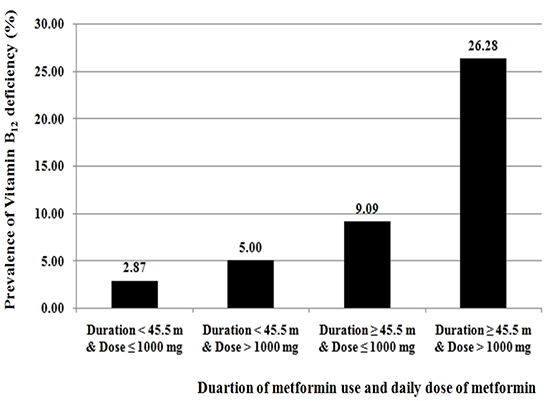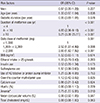1. Mazokopakis EE, Starakis IK. Recommendations for diagnosis and management of metformin-induced vitamin B12 (Cbl) deficiency. Diabetes Res Clin Pract. 2012; 97:359–367.
2. American Diabetes Association. Standards of medical care in diabetes: 2013. Diabetes Care. 2013; 36:S11–S66.
3. Nathan DM, Buse JB, Davidson MB, Ferrannini E, Holman RR, Sherwin R, Zinman B. American Diabetes Association. European Association for Study of Diabetes. Medical management of hyperglycemia in type 2 diabetes: a consensus algorithm for the initiation and adjustment of therapy: a consensus statement of the American Diabetes Association and the European Association for the Study of Diabetes. Diabetes Care. 2009; 32:193–203.
4. Commiittee of Clinical Practice Guideline. Treatment guideline for diabetes. 4th ed. Seoul: Korean Diabetes Association;2011.
5. Nathan DM, Buse JB, Davidson MB, Heine RJ, Holman RR, Sherwin R, Zinman B. Professional Practice Committee, American Diabetes Association. European Association for the Study of Diabetes. Management of hyperglycaemia in type 2 diabetes: a consensus algorithm for the initiation and adjustment of therapy: a consensus statement from the American Diabetes Association and the European Association for the Study of Diabetes. Diabetologia. 2006; 49:1711–1721.
6. Tomkin GH, Hadden DR, Weaver JA, Montgomery DA. Vitamin-B12 status of patients on long-term metformin therapy. Br Med J. 1971; 2:685–687.
7. De Jager J, Kooy A, Lehert P, Wulffelé MG, van der Kolk J, Bets D, Verburg J, Donker AJ, Stehouwer CD. Long term treatment with metformin in patients with type 2 diabetes and risk of vitamin B-12 deficiency: randomised placebo controlled trial. BMJ. 2010; 340:c2181.
8. Ting RZ, Szeto CC, Chan MH, Ma KK, Chow KM. Risk factors of vitamin B(12) deficiency in patients receiving metformin. Arch Intern Med. 2006; 166:1975–1979.
9. Bauman WA, Shaw S, Jayatilleke E, Spungen AM, Herbert V. Increased intake of calcium reverses vitamin B12 malabsorption induced by metformin. Diabetes Care. 2000; 23:1227–1231.
10. Bell DS. Metformin-induced vitamin B12 deficiency presenting as a peripheral neuropathy. South Med J. 2010; 103:265–267.
11. Pierce SA, Chung AH, Black KK. Evaluation of vitamin B12 monitoring in a veteran population on long-term, high-dose metformin therapy. Ann Pharmacother. 2012; 46:1470–1476.
12. Pflipsen MC, Oh RC, Saguil A, Seehusen DA, Seaquist D, Topolski R. The prevalence of vitamin B(12) deficiency in patients with type 2 diabetes: a cross-sectional study. J Am Board Fam Med. 2009; 22:528–534.
13. Lindenbaum J, Healton EB, Savage DG, Brust JC, Garrett TJ, Podell ER, Marcell PD, Stabler SP, Allen RH. Neuropsychiatric disorders caused by cobalamin deficiency in the absence of anemia or macrocytosis. N Engl J Med. 1988; 318:1720–1728.
14. Kim BJ, Kim BS, Kang JH. Alcohol consumption and incidence of metabolic syndrome in korean men: a 3-year follow-up study. Circ J. 2012; 76:2363–2371.
15. Wang J, Geiss LS, Cheng YJ, Imperatore G, Saydah SH, James C, Gregg EW. Long-term and recent progress in blood pressure levels among U.S. adults with diagnosed diabetes, 1988-2008. Diabetes Care. 2011; 34:1579–1581.
16. Long AN, Atwell CL, Yoo W, Solomon SS. Vitamin B(12) deficiency associated with concomitant metformin and proton pump inhibitor use. Diabetes Care. 2012; 35:e84.
17. WHO/UNICEF/UNU. Iron deficiency anemia: assessment, prevention, and control. Geneva: World Health Organization;2001. p. 1–130.
18. Molitch ME, DeFronzo RA, Franz MJ, Keane WF, Mogensen CE, Parving HH, Steffes MW. American Diabetes Association. Nephropathy in diabetes. Diabetes Care. 2004; 27:S79–S83.
19. Ko SH, Kim SR, Kim DJ, Oh SJ, Lee HJ, Shim KH, Woo MH, Kim JY, Kim NH, Kim JT, et al. 2011 clinical practice guidelines for type 2 diabetes in Korea. Diabetes Metab J. 2011; 35:431–436.
20. Chung HH, Moon JS, Yoon JS, Lee HW, Won KC. The relationship between metformin and cancer in patients with type 2 diabetes. Diabetes Metab J. 2013; 37:125–131.
21. Park IB, Baik SH. Epidemiologic characteristics of diabetes mellitus in Korea: current status of diabetic patients using Korean Health Insurance database. Korean Diabetes J. 2009; 33:357–362.
22. Reinstatler L, Qi YP, Williamson RS, Garn JV, Oakley GP Jr. Association of biochemical B12 deficiency with metformin therapy and vitamin B12 supplements: the National Health and Nutrition Examination Survey, 1999-2006. Diabetes Care. 2012; 35:327–333.
23. Nervo M, Lubini A, Raimundo FV, Faulhaber GA, Leite C, Fischer LM, Furlanetto TW. Vitamin B12 in metformin-treated diabetic patients: a cross-sectional study in Brazil. Rev Assoc Med Bras. 2011; 57:46–49.
24. Lim HS, Heo YR. Plasma total homocysteine, folate, and vitamin B12 status in Korean adults. J Nutr Sci Vitaminol (Tokyo). 2002; 48:290–297.
25. Korea Health Statistics 2011: Korea National Health and Nutrition Examination Survey (KNHANES V-2). Korea Centers for Disease Control and Prevention Ministry of Health and Welfare;2011.
26. Wulffelé MG, Kooy A, Lehert P, Bets D, Ogterop JC, Borger van der Burg B, Donker AJ, Stehouwer CD. Effects of short-term treatment with metformin on serum concentrations of homocysteine, folate and vitamin B12 in type 2 diabetes mellitus: a randomized, placebo-controlled trial. J Intern Med. 2003; 254:455–463.
27. Leishear K, Boudreau RM, Studenski SA, Ferrucci L, Rosano C, de Rekeneire N, Houston DK, Kritchevsky SB, Schwartz AV, Vinik AI, et al. Relationship between vitamin B12 and sensory and motor peripheral nerve function in older adults. J Am Geriatr Soc. 2012; 60:1057–1063.
28. Naha K, Dasari S, Vivek G, Prabhu M. Vitamin B
12 deficiency: an unusual cause for recurrent generalised seizures with pancytopaenia. BMJ Case Rep. 2012. doi:
10.1136/bcr-2012-006632.
29. Durand C, Mary S, Brazo P, Dollfus S. Psychiatric manifestations of vitamin B12 deficiency: a case report. Encephale. 2003; 29:560–565.
30. Hin H, Clarke R, Sherliker P, Atoyebi W, Emmens K, Birks J, Schneede J, Ueland PM, Nexo E, Scott J, et al. Clinical relevance of low serum vitamin B12 concentrations in older people: the Banbury B12 study. Age Ageing. 2006; 35:416–422.
31. Carmel R. Pernicious anemia: the expected findings of very low serum cobalamin levels, anemia, and macrocytosis are often lacking. Arch Intern Med. 1988; 148:1712–1714.
32. Stabler SP, Allen RH, Savage DG, Lindenbaum J. Clinical spectrum and diagnosis of cobalamin deficiency. Blood. 1990; 76:871–881.
33. Wickramasinghe SN. Diagnosis of megaloblastic anaemias. Blood Rev. 2006; 20:299–318.
34. Chan CW, Liu SY, Kho CS, Lau KH, Liang YS, Chu WR, Ma SK. Diagnostic clues to megaloblastic anaemia without macrocytosis. Int J Lab Hematol. 2007; 29:163–171.








 PDF
PDF ePub
ePub Citation
Citation Print
Print






 XML Download
XML Download